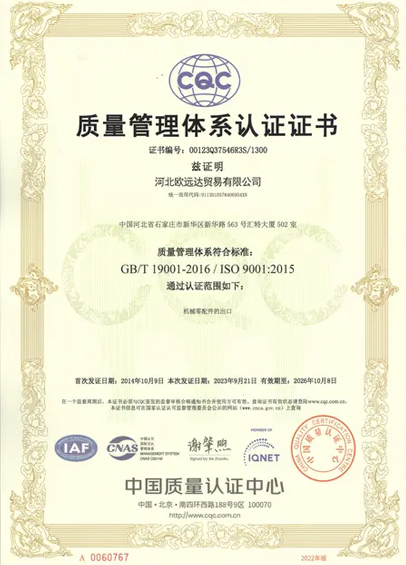Mobile:+86-311-808-126-83
Email:info@ydcastings.com
Cost Analysis of Water Motor Impellers for Efficient Performance in Various Applications
The Economics of Water Motor Impellers Understanding Prices and Market Trends
Water motor impellers are vital components in many hydraulic and pumping systems. They are designed to convert rotational energy from the motor into kinetic energy in the water, effectively increasing water flow and pressure for various applications. The price of water motor impellers is influenced by several factors, including materials, manufacturing processes, design, and market demand. A comprehensive understanding of these elements can help consumers and businesses make informed purchasing decisions.
Factors Influencing Impeller Prices
1. Material Quality The choice of materials is perhaps the most significant factor impacting the price of water motor impellers. Impellers can be made from various materials, including plastic, stainless steel, bronze, and cast iron. Stainless steel and bronze impellers, for instance, offer excellent corrosion resistance and durability, making them more expensive than their plastic counterparts. Consumers must weigh the initial investment against the longevity and performance of different materials.
2. Manufacturing Processes The method used to manufacture impellers also affects their cost. Impellers can be produced through casting, machining, or molding processes, each carrying different labor and material costs. For instance, precision machined impellers may offer better performance and efficiency but come at a higher price. Conversely, molded plastic impellers might be more affordable, but they may not withstand harsh operating conditions as effectively as metal alternatives.
3. Design and Performance Specifications The design of an impeller, including its size, shape, and blade configuration, can heavily influence its price. High-performance impellers designed for specific applications, such as those used in submersible pumps or high-pressure systems, tend to be more expensive due to their intricate designs and the engineering expertise required for their development. Custom-designed impellers will generally command a higher price point than standard models due to the added design and prototype development costs.
water motor impeller price

4. Market Demand and Competition Like any commodity, the prices of water motor impellers are subject to market dynamics. Fluctuations in demand, influenced by seasonal changes or shifts in various industries such as agriculture, construction, and municipal water management, can lead to price changes. Additionally, competition among manufacturers plays a crucial role; while high competition may lead to lower prices, monopolistic market conditions can push prices upward.
5. Technological Advances The incorporation of advanced manufacturing technologies such as 3D printing and precision machining has begun to alter the landscape of impeller production. While these technologies can maintain or improve performance at potentially lower costs, the initial investment in such technology can cause prices to vary.
The Importance of Understanding Prices
For businesses and consumers, understanding the price dynamics of water motor impellers is crucial. Overpaying for an impeller due to lack of knowledge can significantly impact project budgets. On the other hand, opting for the lowest price without consideration of quality can lead to increased maintenance costs and reduced system efficiency. Therefore, it is advisable for buyers to conduct thorough research, compare multiple suppliers, and consider the long-term implications of their purchase decisions.
Conclusion
In conclusion, the price of water motor impellers is a multifaceted issue influenced by various factors, including material choice, manufacturing processes, design specifications, market conditions, and technological advancements. Understanding these elements is essential for making educated purchasing decisions that balance cost, performance, and longevity. By investing time in research and evaluating options, consumers can ensure they select the right impeller for their needs, ultimately leading to optimal performance and cost-effectiveness in their applications.
-
Why Should You Invest in Superior Pump Castings for Your Equipment?NewsJun.09,2025
-
Unlock Performance Potential with Stainless Impellers and Aluminum End CapsNewsJun.09,2025
-
Revolutionize Your Machinery with Superior Cast Iron and Aluminum ComponentsNewsJun.09,2025
-
Revolutionize Fluid Dynamics with Premium Pump ComponentsNewsJun.09,2025
-
Optimizing Industrial Systems with Essential Valve ComponentsNewsJun.09,2025
-
Elevate Grid Efficiency with High-Precision Power CastingsNewsJun.09,2025











